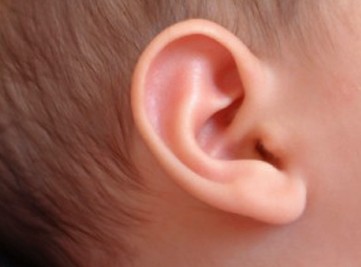Infant Ear Infection - Signs and Symptoms, Causes, Treatment
Pictures

It is difficult for parents to see their babies crying unrelentingly and yet parents could not determine what make the babies cry an awful lot. It is even harder for parents whose babies are still unable to talk and therefore cannot communicate what makes the crying.
Pain and discomfort make babies cry a lot or make them so irritable. Often, parents would toss and turn to think of ways to make their babies comfortable or to make their babies stop from crying. Crying is the method of babies to communicate if something is not going right with them or if they feel awfully uncomfortable.
A lot of reasons can make a baby cry and uncomfortable. Various reasons can make babies uncomfortable such as feeling pain in the ear, stomach and others. Ear pain is one of the most common reasons that make the babies cry. Ear infection is among the most common infection an infant can suffer from and this could be due to a variety of reasons. The onset of ear infection often starts with the colds which is very common among young children and babies.
Otitis media is one example that can cause ear infection among infants. It is a swelling of the Eustachian tube that obstructs the normal flow of fluid and mucus in the ear making both collect in the middle ear which later becomes infected.
Signs and Symptoms
Babies during the first few years of life are susceptible to diseases and infections due to their immune system that is not yet fully developed. Ear infection is the second most common illness among infants and which can make them hard to pacify due to the symptoms they are experiencing. The ear infection should not be disregarded and should be consulted to a pediatrician immediately because if the infection is left untreated it can lead to a more serious health problem.
Most infants by the time they reach a year of life are unable to talk and communicate if they are feeling pain or if something is not right with them. An ear infection on the other hand has warning signs that should alert parents and prompt them to bring their babies to the doctor.
The signs and symptoms of an ear infection in infants are:
- Frequent grabbing of the ear among infant is one sign that something is unusual. Ear grabbing however does not always mean an ear infection especially if it is not associated with other symptoms. Babies often tug their ears for no apparent reasons but constant tugging of the ear accompanied with the symptoms is one telltale sign of a discomfort within their ears.
- Onset of fever has been always common among infant when something is not well with them. Fever is the most common sign and initial symptom of infection. Fever is always a sign that prompt parents to bring their babies to a pediatrician and the pediatrician is the right person to tell if indeed something is wrong with the child such as an ear infection.
- Symptoms of cold such as runny nose that turns yellowish or greenish is an indication of an infection.
- Incessant crying and sudden change in mood is a warning sign that the baby is in pain or uncomfortable. Pain and discomfort are the most reasons for babies to cry incessantly especially if they cannot determine where the pain is coming from. A constant tugging of the ear accompanied with incessant crying and fever should raise suspicion of an ear infection and parents should be prompted to bring their babies to the doctor.
- A noticeable fluid drainage coming from the ear characterized with whitish or yellowish discharge is a sure sign of infection. Fluid drainage from the ear is also one sign that a hole in the eardrum has developed. Severe cases of ear infection can also lead to rupture of the eardrum and this warrant an immediate visit to the doctor. The fluid coming from the ear is also characterized with a foul odor and may possibly have a tinge of blood. The characteristic of the fluid is rather unusual from the normal earwax.
- Vomiting and diarrhea may also occur with an ear infection. The harmful pathogen that caused the infection may also infect the gastrointestinal tract that can cause the diarrhea and vomiting as well.
- Disruption in sleeping pattern accompanied by restlessness or incessant crying when the baby is lying down is also a telltale sign of discomfort and pain. Incessant crying is often due to the pain perceived by the infant who cannot communicate what they are experiencing. Crying is also the way a baby to say they are uncomfortable.
- Loss of appetite is common among infants suffering from pain and discomfort. The pain perceived will often drive the baby to lose appetite even if they are hungry. Infants often pull away from their feeding bottle or when breastfeeding after a few sips. Ear infection is causing pain that can affect the interest in feeding among infants.
Causes
Most ear infections are caused by a virus or bacteria. It often occurs when there is a fluid buildup behind the eardrum and collects in the middle ear. The fluid and mucus buildups will later collect bacteria and cause a harmful effect within the ear of an infant.
Otitis media is particularly a common occurrence among infants. It is a disease caused by an infection in the middle ear or caused by the inflammation of the middle ear which can cause swelling and obstruction of the Eustachian tube. It is a contagious infection and a common childhood illness. Infants are more prone to this disease because of their weak immune system which is still immature or developing. The anatomical structure of the Eustachian tubes in infants is shorter and more horizontal compared to adults. This makes the function of the Eustachian tube in infants less effective in protecting the ear from infection.
The Eustachian tube of a baby is smaller in diameter and in length that an obstruction can easily occur. The obstruction in the Eustachian tube can occur if the baby is suffering from common colds, seasonal allergy and sinus infection.
The middle ear is the perfect place for harmful pathogens to breed and thrive as the middle ear is rather dark, moist and warm. The onset of respiratory infection is often associated with an ear infection and because of the anatomical structure of the Eustachian tube in infants it makes it easier for the bacteria or virus to reach the middle ear subsequently ear infection.
Treatment
If signs and symptoms of ear infection are present, this should prompt parents to consult a doctor right away and not to attempt to treat their babies on their own. This could only make the matter worse and may result in irreversible damage especially if the infection has been complicated.
Antibiotic is the initial treatment that doctors often prescribed in confirmed ear infection. A full dose of antibiotic should be given as per instruction of the doctor. Recurrence of infection and antibiotic resistance are possible if full dose of antibiotic is not administered accordingly.
The fever and pain are relieved with prescription of acetaminophen or ibuprofen. Aspirin is contraindicated and should not be given due to risk of Reye’s syndrome which is a rare but potentially fatal disorder.
An ear-drop may also be prescribed while minor surgery may be required for more serious cases of ear infection. Minor surgery is indicated to drain fluid coming from the infected eardrum.
Regular visits to the doctor are necessary during the course of treatment to ensure that the medication prescribed is working well and if the baby is responding to the treatment. A periodical examination of the ear during the course of treatment may also be necessary to rule out other chronic conditions.





